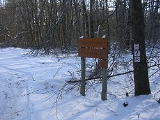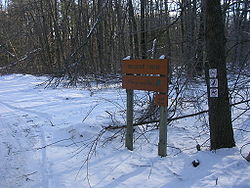
Sheldrick Forest Preserve
Encyclopedia

Forest
A forest, also referred to as a wood or the woods, is an area with a high density of trees. As with cities, depending where you are in the world, what is considered a forest may vary significantly in size and have various classification according to how and what of the forest is composed...
located in West Wilton, New Hampshire
Wilton, New Hampshire
- Demographics :As of the census of 2000, there were 3,743 people, 1,410 households, and 1,023 families living in the town. The population density was 145.3 people per square mile . There were 1,451 housing units at an average density of 56.3 per square mile...
and owned by The Nature Conservancy
The Nature Conservancy
The Nature Conservancy is a US charitable environmental organization that works to preserve the plants, animals, and natural communities that represent the diversity of life on Earth by protecting the lands and waters they need to survive....
. The 227 acre (0.91863722 km²) property is host to a large diversity
Biodiversity
Biodiversity is the degree of variation of life forms within a given ecosystem, biome, or an entire planet. Biodiversity is a measure of the health of ecosystems. Biodiversity is in part a function of climate. In terrestrial habitats, tropical regions are typically rich whereas polar regions...
of old growth trees and a number of plants. The preserve's three miles of trails are available to the public.
History
The Sheldrick forest was owned by the Sheldrick family since 1897. For more than 150 years, the forest was kept largely undisturbed by loggingLogging
Logging is the cutting, skidding, on-site processing, and loading of trees or logs onto trucks.In forestry, the term logging is sometimes used in a narrow sense concerning the logistics of moving wood from the stump to somewhere outside the forest, usually a sawmill or a lumber yard...
or agriculture
Agriculture
Agriculture is the cultivation of animals, plants, fungi and other life forms for food, fiber, and other products used to sustain life. Agriculture was the key implement in the rise of sedentary human civilization, whereby farming of domesticated species created food surpluses that nurtured the...
. However, in December 1994, the property was sold to a developer who sought to exploit the land for both timber and gravel deposits.
The forester hired to evaluate the land's economic worth, Swift Corwin, recognized the value of the land and contacted The Nature Conservancy in 1995. The original owner agreed to sell the property for several hundred thousand dollars, which was paid in April 1996 through several donations and fundraising
Fundraising
Fundraising or fund raising is the process of soliciting and gathering voluntary contributions as money or other resources, by requesting donations from individuals, businesses, charitable foundations, or governmental agencies...
events.
Natural history
The Sheldrick Forest Preserve was affected heavily by glacialGlacier
A glacier is a large persistent body of ice that forms where the accumulation of snow exceeds its ablation over many years, often centuries. At least 0.1 km² in area and 50 m thick, but often much larger, a glacier slowly deforms and flows due to stresses induced by its weight...
drift activity approximately 18,000 years ago. Signs of the glacial activity are still visible today. The stone wall
Dry stone
Dry stone is a building method by which structures are constructed from stones without any mortar to bind them together. Dry stone structures are stable because of their unique construction method, which is characterized by the presence of a load-bearing facade of carefully selected interlocking...
s and stone bridge
Bridge
A bridge is a structure built to span physical obstacles such as a body of water, valley, or road, for the purpose of providing passage over the obstacle...
s in some areas of the forest are indicators of more recent activity, likely being built in the early 19th century.
The land has a diverse selection of tree species, and contains more than six natural communities, including the rich mesic forest, hemlock
Tsuga
Tsuga is a genus of conifers in the family Pinaceae. The common name hemlock is derived from a perceived similarity in the smell of its crushed foliage to that of the unrelated plant poison hemlock....
-pine
Pine
Pines are trees in the genus Pinus ,in the family Pinaceae. They make up the monotypic subfamily Pinoideae. There are about 115 species of pine, although different authorities accept between 105 and 125 species.-Etymology:...
ravine forest, black beech
Beech
Beech is a genus of ten species of deciduous trees in the family Fagaceae, native to temperate Europe, Asia and North America.-Habit:...
forest, red birch
Birch
Birch is a tree or shrub of the genus Betula , in the family Betulaceae, closely related to the beech/oak family, Fagaceae. The Betula genus contains 30–60 known taxa...
forest, oak
Oak
An oak is a tree or shrub in the genus Quercus , of which about 600 species exist. "Oak" may also appear in the names of species in related genera, notably Lithocarpus...
forest, and a stand of butternut
Butternut (tree)
Juglans cinerea, commonly known as Butternut or White Walnut, is a species of walnut native to the eastern United States and southeast Canada. Its range extends east to New Brunswick, and from southern Quebec west to Minnesota, south to northern Alabama and southwest to northern Arkansas...
trees. In addition to the trees, there is an abundance of mountain laurel, several stream
Stream
A stream is a body of water with a current, confined within a bed and stream banks. Depending on its locale or certain characteristics, a stream may be referred to as a branch, brook, beck, burn, creek, "crick", gill , kill, lick, rill, river, syke, bayou, rivulet, streamage, wash, run or...
s, and interior forest breeding birds.

